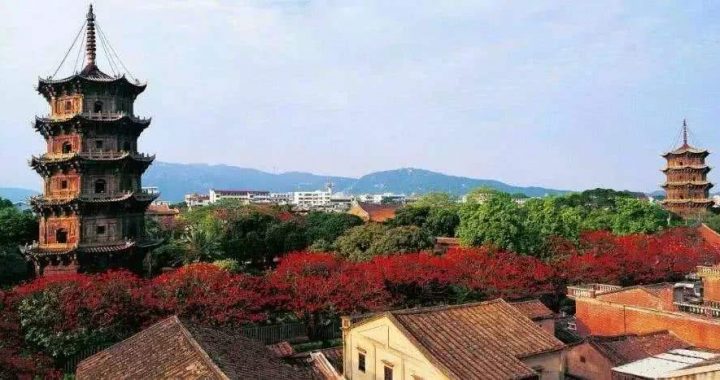Twin Pagodas in Kaiyuan Temple
5 min readTwin Pagodas in Kaiyuan Temple of Quanzhou, Fujian province are beautiful in appearance and exquisite in structure.
Twin Pagodas in Kaiyuan Temple, also known as Quanzhou Twin Pagodas, locate at the two sides of Ziyun (purple clouds) Hall in Kaiyuan Temple. Standing separately on the east and west, these two pagodas are 200 meters apart. The eastern pagoda, Zhenghuo Pagoda, was built in 865 and is 48.24 meters high; and the western one, Renshou Pagoda, was built in 916 and is 44.06 meters high.
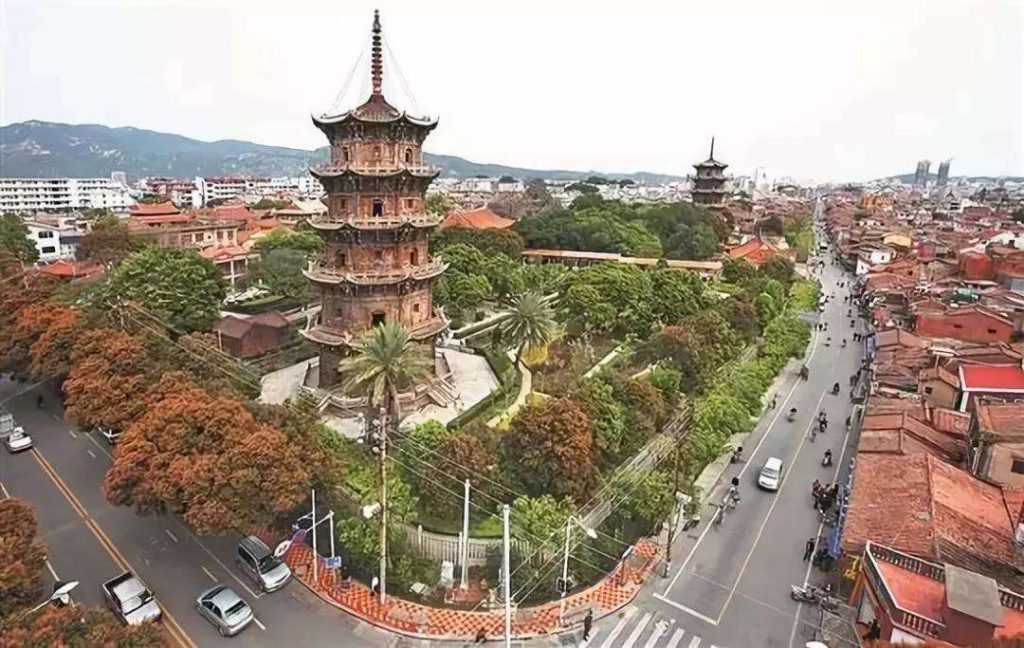
The Twin pagodas are five-storied octagonal tower-like stone ones. They are similar to each other in modeling. These two pagodas were initially wooden ones and rebuilt with stones afterwards. The throne of Mt. Sumeru at the base is delicate. They are extremely exquisite among all stone pagodas of the same type. Differentfrom other brick pagodas in structure, which are usually centering or spiraling, these two pagodas do not set up their stairs on the center pillar or against the walls. Instead, there sets specially a hole on one side of the central pillar for the stairs as wooden pagodas do. The central pillar is a solid pillar cast with stones. There is a central room in the pagodas and an oblong niche on the wall opposite to the gate. Statues of Buddha are put in the niches. Big stones overlap each other in two layers and bricks are tightly laid on these stones, forming the stairs inside the pagodas. The pinnacle is delicate and erect. It is a typical metal tower-like pinnacle with a bronze gourd at the top. Eight chains are used to connect the pinnacle together with the eight ridges on the top in order to prevent thepinnacle from shaking. Besides, there are 40 bronze wind bells hanging under the eight ridges.
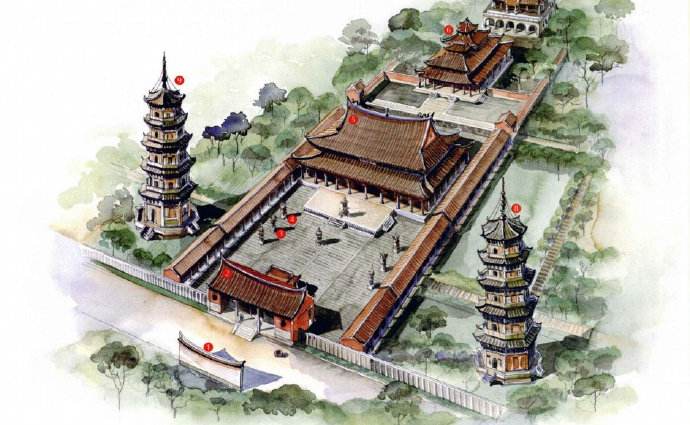
Zhengguo Pagoda in the east was originally a nine-storied wooden pagoda. It was destroyed several times and then built up again. Just in the Southern Song dynasty, this pagoda was destroyed two times. In 1227, it was rebuilt into a seven-storied brick pagoda. Then, it was rebuilt into a five-storied octagonal tower-style woodenstructured granite pagoda during the period from 1238 to 1250 and preserved until today. There are four doors opened on each layer of the pagoda. Four niches are also set on each layer, but in different positions. Outside the pagoda there are covered corridor and stone railing, on which people can walk around the pagoda. The pinnacle is made of a base, an unturned alms bowl,a precious pearl, an opening lotus, Buddhist wheels,a flower plate and a precious vase. The vase is a gourd-shaped bronzed one. It is unique in appearance and delicate in craftsmanship. It is said that Monk Faquan, who was in charge of the east pagoda’s building, passed away aftethe fourth story was completed. An Indian monk Tianjun inherited Faquan’s will and finished the work, receiving the respect and esteem of Chinese people. Therefore, this eastern pagoda became a witness of the friendship between Chinese and Indian people.
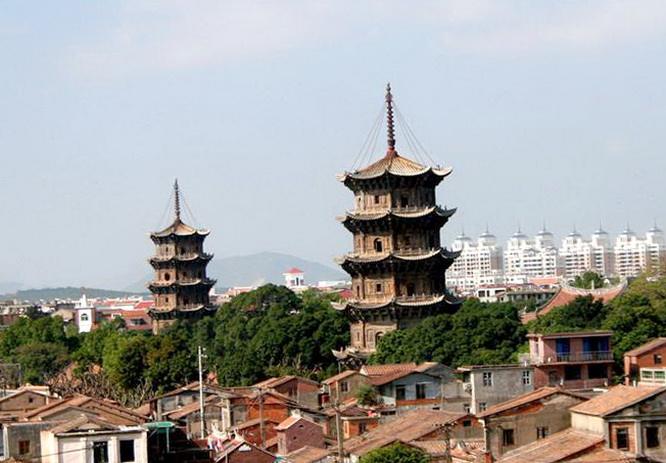
According to Buddhist viewpoint, the eastern pagoda stands for the miserable world in the east, where Sakyamuni spread his teachings. The pagoda consists of five stories, standing for the five vehicles of Buddhism, which mean the five idealstates in Buddhism, and the five stages Buddhists achieve during practice. The frescos on the pagoda are also arranged in the order of the five stages: from bottom to top, the first layer is Buddha vehicle, carved with statues of Sakyamuni and his metamorphosis image; the second layer is Bhodisattva vehicle, carved with statues of Bodhisattvas with the supernatural power and magic power; the third layer is Pratyeka-Buddha vehicle carved with statues of the founders of major Buddhism sects and eminent monks who have contributed a lot in the development of Buddhism inChina; the fourth layer is Sravaka vehicle, carved with 16 statues of Arhats; the fifth layer is men and heaven vehicle, carved with statues of the Eight classes of supernatural beings, the Four Great Heavenly Kings and Gods of Power responsible for protecting the pagodas, Buddhism and subduing the evil spirits. These reliefs of figures are with distinctive Chinese features.
Bodhisattva, Arhats and the Four Great Heavenly Kings are all in the same appearances as Chinese people and wear the clothes in the style of the Song dynasty.
Among them, the statue of bearded Avalokitesvara embodies the viewpoint of the Southern Song dynasty that Avalokitesvara is male among Indian Buddhism. All the reliefs are delicately and daintily carved. All the figures are vivid, vigorous and lifelike. In addition, there also carved on the throne of Mt. Sumeru stories of the birth and life of Buddha, the roaming of Buddha and some other historic records and fantastic anecdotes in Buddhism. What’s more, on the outer wall of the pagoda, there are about 80 relief statues of Buddha. They are exquisitely in craftsmanship and vivid in appearance.
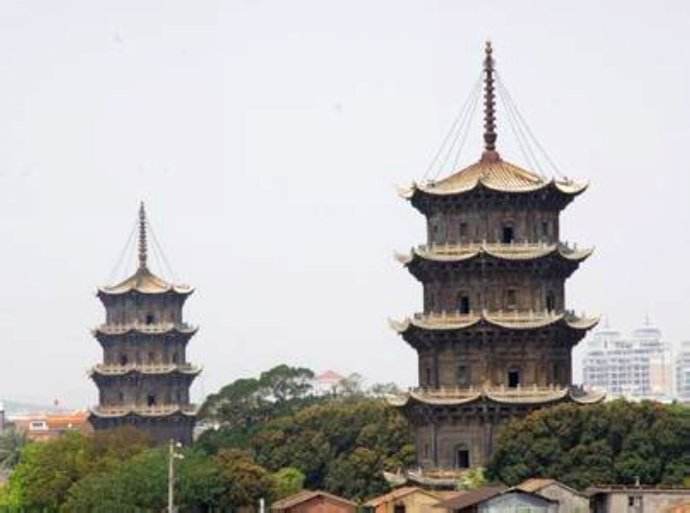
Renshou Pagoda in the west was also destroyed in fires in the Southern Song dynasty. It was rebuilt with bricks in the Northern Song dynasty and with stones in the Southern Song dynasty. It is also built into a five-storied octagonal tower-style wooden-structured granite one. It is almost the same as that of the eastern pagoda. They are different only in the types of reliefs carved on the body part. The western pagoda stands for Western pure land, while its octagonal modeling stands for the Eight Shambala(bright and clean lands in Buddhism). Therefore, the figures on the reliefs include not only Gods of Power, but also Bodhisattva of great mercy andgreat pity, the eminent monks who have attained the enlightenment and the believers who are converted to Buddhism, such as the pious Monk Xuanzhuang and Emperor Wudi in the Liang dynasty-Xiao Yan. These vivid and lifelike images are of first class in the artistic treasure hall. The most eye catching one is a monkey-shaped relief in the northeast wall of the fourth floor, which is similar to the image of Monkey King in the novel Pilgrimage to the West. In addition, at the corners of each layer, there carved strange-modeled round pillars, which is rarely seen in other ancient constructions. Besides, there are bases with railings stretching outside the pagoda at each layer. People can stand on the base and have a good view of the beautiful sceneries around. This bold design is rare among the brick and stone pagodas in the north.
